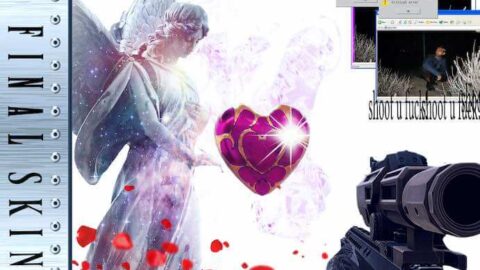If you enjoy contemporary classical music and artists like 100 gecs, Arca, and SOPHIE, I may have found your new favorite album. Rohan Chander is the artist and producer behind the BAKUDI SCREAM alias, and on his latest album, FINAL SKIN (Cantaloupe Music), he masterfully weaves together diverse aesthetic threads spun from video game soundtracks, hyperpop, avant-garde improvisation, and more to create an entirely new sonic fabric. FINAL SKIN isn’t an album you can listen to passively — it demands that its listeners suit up and prepare for adventure.
Throughout FINAL SKIN, performances by Vicky Chow on keyboards, Yaz Lancaster on violin, Dorothy Carlos on cello, and Dani Strigi on electric guitar, drums, and bass are mixed in with various text-to-speech voices that convey their desires, pleas, lamentations, and dreams. Less refined than Siri or Alexa, these voices resemble clunky software from the early 2000s.. In the first track, “interview (character select),” one such voice asks a series of prying questions about sex, isolation, and hot Cheetos. At once amusing and off-putting, the track ends with a final statement that is truncated as the voice dies off: “If this question makes you uncomfortable, please hit ski—“.

In “The Tragedy of Hikikomori Loveless,” we encounter another synthetic voice, this time belonging to a hikikomori. This Japanese term describes the phenomenon of acute social withdrawal, as well as the individuals who experience this extreme social isolation. The hikikomori in this track makes chains of cyclical statements like, “I can be beautiful if I want it. I can be alone if wanted. I will be alone if it’s not wanted. I will be alone because I’m not wanted. I will be here in case I’m beautiful.” Irregular stresses on words like “beautiful” sound unnatural or forced, in turn making these statements even bleaker. We get the impression that behind this shell of a voice is a radiant being who struggles to find their home in worlds virtual or actual.
“The Tragedy of Hikikomori Loveless” shuttles listeners back and forth between two opposing sonic worlds. The first is an oversaturated cacophony of EDM, static, and various beeps and squeaks. The second is a patina of droning sounds, such as the resonance from a MIDI choir instrument and the whirring white noise of domestic appliances. This contrast perfectly captures the same uncanny dissociation you may feel if you’ve ever played a video game for so long that reality begins to resemble a sort of simulation.
Speaking of video games, the cover art for FINAL SKIN (also created by BAKUDI SCREAM) is a nostalgia-soaked emblem of the medium. I spotted a heart container from The Legend of Zelda, the arms and weapon of a first-person shooter character, and signature elements from the Final Fantasy series such as the stark white background and angular title font. A number of “critical error” pop-up windows crowd the album cover, alluding to some of the dissonant themes BAKUDI SCREAM explores with the album.

Another standout track is “HINDOO WARRIOR & THE FUTURANGEL,” in which BAKUDI SCREAM creates the illusion of space and movement with broad washes of uptempo beats. With the energy of a video game speedrunner, this track flies through vast spaces occupied by minimalist MIDI choir riffs, an ecosystem of synth pads, and plenty of laser beams. A number of text-to-speech voices allude to the deeper mythology that is at the heart of FINAL SKIN. On repeat listens, you may uncover details about an ancient keyboard relic that is “passed down through many generations and wielded by mystics, mages, and heroes.” (BAKUDI SCREAM) In a fun twist on the fantasy trope, this relic is adaptive rather than static: users implant bits of themselves in the relic, which impacts the nature of the object and its future wielders.
Somewhere inside of its flawlessly executed, stylistically dense music, FINAL SKIN asks some pretty big questions. What ancient relics do we wield in our artistic practices, and what pieces of ourselves do we implant in those media for future generations? In operating more and more online as a society, do we limit ourselves or find greater freedom? Where is the line between the virtual and actual when it comes to identity (or is there a line at all)?
The answers to these questions are not so straightforward, but FINAL SKIN offers listeners an intricately conceived open world in which to explore them sonically. Like any great video game that offers players who have completed it the chance to replay in NG+ (new game plus), you may find yourself listening to FINAL SKIN again and again to uncover its shadowy mythos and to meditate on its glimpses of possible futures for humanity. This is one adventure I didn’t want to end.
I CARE IF YOU LISTEN is an editorially-independent program of the American Composers Forum, funded with generous donor and institutional support. Opinions expressed are solely those of the author and may not represent the views of ICIYL or ACF.
A gift to ACF helps support the work of ICIYL. For more on ACF, visit the “At ACF” section or composersforum.org.
























